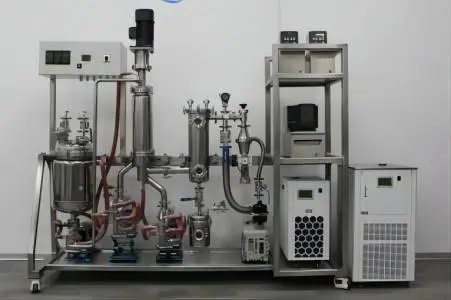Vacuum Distillation Using Wiped Film Evaporators and Short Path Evaporators
Are you struggling with inefficient separation processes that degrade your heat-sensitive compounds? Traditional distillation methods often fail when dealing with high-boiling materials, thermally unstable substances, or complex mixtures requiring precise fractionation. Vacuum distillation using wiped film evaporators and Short Path Wiped Film Distillation technology offers a revolutionary solution that operates at lower temperatures under vacuum conditions, protecting valuable compounds while achieving exceptional purity levels. This advanced separation technique has transformed industries from pharmaceuticals to petrochemicals, delivering recovery rates up to 70% compared to conventional methods' mere 16%. The integration of vacuum technology with thin film evaporation creates an environment where molecular-level separation occurs efficiently and safely. Short Path Wiped Film Distillation systems utilize the principle that different molecules travel varying distances under vacuum, enabling precise component isolation without thermal degradation. Industries worldwide are adopting this technology to purify fish oils, regenerate lubricants, refine essential oils, and synthesize pharmaceutical intermediates with unprecedented quality standards.

Understanding Short Path Wiped Film Distillation Technology
Short Path Wiped Film Distillation represents a breakthrough in separation science that addresses fundamental limitations of traditional distillation. This technology exploits the mean free path differences between molecules under high vacuum conditions, allowing selective evaporation and condensation within extremely short distances. The process operates at pressures as low as 0.001 mbar, reducing boiling points dramatically and preventing thermal decomposition of sensitive materials. The core advantage lies in the minimal residence time of materials on heated surfaces. Unlike conventional distillation where products may spend hours at elevated temperatures, Short Path Wiped Film Distillation exposes materials to heat for mere seconds. A mechanical wiper blade continuously spreads the feed material into an ultra-thin film across the heated evaporator wall, maximizing surface area while minimizing thermal exposure. Evaporated molecules travel directly to a nearby internal condenser positioned just centimeters away, ensuring rapid cooling and collection.
Working Principles of Vacuum Distillation Systems
Vacuum distillation systems function by creating a pressure environment where molecular collisions become infrequent enough that evaporated molecules can travel significant distances without interference. In Short Path Wiped Film Distillation equipment, the evaporator surface is heated to temperatures appropriate for the target compound's vapor pressure at the operating vacuum level. As the thin film of material contacts this surface, volatile components rapidly evaporate and move toward the cooled internal condenser following a straight-line trajectory. The distance between evaporation and condensation surfaces typically ranges from 20 to 50 millimeters, matching the mean free path of molecules at the operating pressure. This geometric arrangement ensures that desired molecules reach the condenser while heavier, less volatile components remain in the residue stream. Multiple stages can be configured in series, with each stage operating at different temperatures to fractionate complex mixtures into distinct products with tailored compositions.
Multi-Stage Separation for Complex Mixtures
Industrial applications frequently require multi-stage Short Path Wiped Film Distillation systems to achieve target purity specifications. Well One's advanced designs integrate up to four distillation stages, each maintained at independent vacuum levels and heating temperatures. The first stage typically functions as a thin film evaporator to remove low-boiling solvents and moisture, reducing residual content below 500 ppm. Subsequent molecular distillation stages progressively enrich specific components or remove particular impurities. This cascade approach enables separation of compounds with similar boiling points that would be impossible to fractionate in single-stage equipment. For example, in fish oil purification, the four-stage system separates EPA and DHA ethyl esters from other fatty acids while simultaneously removing color bodies, peroxides, and odor compounds. Each stage features individual temperature control through dedicated heating circulation systems, allowing precise optimization of separation parameters for maximum yield and purity.
Applications Across Industrial Sectors
Short Path Wiped Film Distillation technology serves diverse industries confronting challenging separation requirements. In pharmaceutical manufacturing, the technique produces ultra-pure polyethylene glycol with narrow molecular weight distributions impossible to achieve through batch polymerization. The controlled environment prevents oxidative degradation while removing oligomers and unreacted monomers, yielding pharmaceutical-grade excipients with dispersity indices below 1.05. The food industry leverages this technology extensively for omega-3 fatty acid concentration. Traditional fish oil processing recovers only 16% of valuable EPA and DHA due to thermal degradation during prolonged heating. Short Path Wiped Film Distillation systems achieve 70% recovery rates while producing oils with superior color, minimal fishy odor, and low peroxide values. The vacuum environment prevents oxidation of unsaturated bonds, preserving nutritional quality and extending shelf life.
Petrochemical Industry Solutions
Waste lubricating oil regeneration exemplifies the economic and environmental benefits of Short Path Wiped Film Distillation in petrochemicals. Conventional chemical refining methods generate hazardous waste streams and corrode equipment through aggressive acid treatments. The molecular distillation approach physically separates degraded additives, oxidation products, and contaminants without chemicals, recovering high-quality base oils suitable for reblending. The multi-stage configuration enables production of multiple base oil grades with different viscosity characteristics from a single waste feed. After pre-treatment removes particulates and water, the first distillation stage recovers light base oil fractions. Heavier components from the first stage become feedstock for the second stage, which produces medium-viscosity base oils. This sequential processing continues until all valuable fractions are recovered, with only truly spent materials exiting as residue.
Fine Chemicals and Specialty Products
The synthesis of monoglycerides demonstrates Short Path Wiped Film Distillation's precision in fine chemical applications. Glycerin monostearate production traditionally yields mixtures containing mono-, di-, and triglycerides that require extensive purification. The molecular distillation process selectively removes glycerol, free fatty acids, and higher esters in staged operations, delivering monoglyceride purity exceeding 95%. Essential oil purification represents another high-value application where product quality directly impacts market price. Rose essential oil extracted by supercritical CO2 contains waxes, color bodies, and oxidation products that diminish fragrance quality. Short Path Wiped Film Distillation refines crude rose oil at temperatures below 100°C under deep vacuum, preserving delicate aromatic compounds while removing impurities. The resulting product exhibits superior olfactory characteristics and commands premium pricing.
Technical Specifications and System Design
Well One's WMD-200-4 model exemplifies the engineering sophistication of modern Short Path Wiped Film Distillation systems. This four-stage configuration features 2 square meters of evaporator area per stage with 8 square meters of internal cooling surface. The 500mm diameter evaporator employs magnetic sealing technology, eliminating dynamic seal leakage while withstanding the extreme vacuum conditions required for molecular distillation. Precision gear pumps deliver feed rates from 20 to 100 liters per hour with variable frequency speed control, ensuring consistent film formation across the evaporator surface. All material-contact components are fabricated from SS316L stainless steel, providing corrosion resistance for aggressive chemicals while meeting pharmaceutical industry standards. Jacketed piping maintains material temperatures throughout the system, preventing crystallization or viscosity increases that could disrupt flow.
Heating and Cooling Infrastructure
Effective thermal management is critical for Short Path Wiped Film Distillation performance. The WMD-200-4 incorporates four independent heating circulation systems: a main evaporator heater operating from room temperature to 300°C with 38 kW power and 110 L/min flow rate; a material insulation heater maintaining temperatures up to 200°C; an internal condenser unit with combined heating and cooling capability spanning -20°C to 200°C; and an external condenser chiller reaching -80°C for volatile component recovery. This sophisticated thermal control enables optimization of each distillation stage independently. The first stage might operate at 150°C to flash off solvents, while subsequent stages run at progressively higher temperatures to fractionate target components. The internal condenser temperature is adjusted to selectively condense desired products while allowing lighter components to pass through to the external condenser or vacuum system.
Vacuum System Architecture
Achieving and maintaining the ultra-high vacuum levels required for molecular distillation demands robust pumping capacity. The WMD-200-4 employs a two-stage vacuum system combining a rotary vane pump (TRP-90 providing 30 L/s capacity) with a Roots blower (ZJ300 delivering 300 L/s). This combination rapidly evacuates the system to operating pressure while handling process vapor loads without performance degradation. Pressure isolation devices between distillation stages allow each stage to operate at its optimal vacuum level independently. This design feature is particularly valuable when processing materials with wide boiling point distributions, as early stages can function at moderate vacuum to efficiently remove bulk solvents while later stages operate at extreme vacuum for difficult separations. Sampling ports between stages enable real-time monitoring of separation efficiency and product quality.
Operational Advantages and Process Benefits
Short Path Wiped Film Distillation systems deliver compelling operational advantages beyond simple separation capability. Continuous 24-hour operation without shutdown enables consistent product quality while maximizing equipment utilization. The automated control systems maintain precise temperature, pressure, and flow rate setpoints, reducing operator intervention requirements and minimizing batch-to-batch variability. Safety and environmental performance represent additional benefits of the technology. Operating under vacuum and at reduced temperatures minimizes fire and explosion risks compared to atmospheric pressure distillation. The closed-loop design prevents volatile emissions, capturing all process vapors for product recovery or proper disposal. Energy consumption is substantially lower than conventional distillation due to reduced heating requirements and efficient heat transfer in thin films.
Quality Assurance and Certification
Well One's commitment to quality is demonstrated through comprehensive testing and certification programs. All equipment undergoes rigorous factory acceptance testing before shipment, verifying vacuum integrity, temperature control accuracy, and mechanical performance. The manufacturing facility holds ISO9001 quality system certification and operates a UL-accredited testing laboratory. Electrical components comply with UL listing requirements and explosion-proof environmental standards. Materials traceability is maintained throughout fabrication, with test certificates provided for all steel, seals, and critical components. Suppliers undergo annual audits and rating evaluations to ensure consistent quality. Important components such as pumps, motors, and control systems are sourced from internationally recognized brands, providing reliability and service support worldwide. Core technologies are protected through patents and intellectual property rights.
Customization Capabilities for Specific Applications
Every separation challenge presents unique requirements that benefit from customized equipment design. Well One's engineering team collaborates with clients to develop optimized solutions incorporating process development expertise with mechanical design capability. Projects begin with laboratory testing to establish feasibility and identify critical parameters, followed by pilot-scale trials to refine operating conditions and confirm product specifications. The company's 3D modeling capabilities enable virtual prototyping and layout optimization before fabrication begins. Customization examples include compact designs with minimal footprints for space-constrained facilities, glass feeding systems for visual process monitoring, and specialized configurations for materials requiring dissolution before distillation. The dual-stage 1 square meter wiped film system illustrates how equipment sizing can be tailored to production volume requirements.
Service and Support Infrastructure
Comprehensive service support ensures successful equipment installation and long-term operational excellence. Well One provides complete commissioning services including vacuum testing, thermal calibration, and operator training. Operating platforms integrated into system design facilitate routine maintenance and sampling activities. The modular construction approach enables component replacement without major disassembly. Technical support extends beyond initial startup through remote monitoring capabilities and responsive troubleshooting assistance. The company maintains extensive application experience across multiple industries and compound types, providing valuable process optimization guidance. Spare parts availability is ensured through strategic inventory management, and upgrade pathways exist to incorporate technology improvements into existing installations.
Conclusion
Vacuum distillation using wiped film evaporators and Short Path Wiped Film Distillation technology represents the premier solution for separating heat-sensitive and high-boiling compounds across diverse industries. The combination of low-temperature operation, minimal thermal exposure, and precise fractionation capability delivers superior product quality with maximum yield. Multi-stage configurations enable processing of complex mixtures into multiple purified products while maintaining continuous operation and ensuring environmental compliance.
Cooperate with Xi'an Well One Chemical Technology Co., Ltd
Since 2006, Xi'an Well One Chemical Technology Co., Ltd., supported by Xi'an NewSet Chemical Equipment Technology Co., Ltd., has specialized in synthesis and purification separation equipment. With a 1,500 m² office, 500 m² R&D laboratory, and 4,500 m² factory covering over 5,000 m², the company delivers comprehensive services spanning process development, equipment design, testing, and pilot operations. Its expert team provides molecular distillation devices from laboratory to industrial scale, serving pharmaceutical, food, new materials, petrochemical, essence, and fine chemicals industries.
As a leading China Short Path Wiped Film Distillation factory, China Short Path Wiped Film Distillation supplier, and China Short Path Wiped Film Distillation manufacturer offering China Short Path Wiped Film Distillation wholesale, we provide Short Path Wiped Film Distillation for sale at competitive Short Path Wiped Film Distillation prices. Our High Quality Short Path Wiped Film Distillation equipment features selected materials ensuring top-grade products, OEM & ODM custom designs with 3D animation, and comprehensive R&D, production, sales, and support services. UL electrical certification demonstrates our commitment to safety and reliability. Contact us at info@welloneupe.com to discuss your separation challenges and discover how our proven solutions can optimize your production processes. Bookmark this page for future reference when evaluating distillation technology options.
References
1. "Molecular Distillation: Principles and Industrial Applications" by Batistella, C.B. and Maciel Filho, R., Brazilian Journal of Chemical Engineering, 2015.
2. "Wiped Film Evaporation Technology for Heat-Sensitive Materials" by Stichlmair, J.G. and Fair, J.R., Distillation: Principles and Practice, Wiley-VCH, 2008.
3. "Vacuum Distillation Systems in Pharmaceutical Manufacturing" by Seader, J.D., Henley, E.J., and Roper, D.K., Separation Process Principles, John Wiley & Sons, 2011.
4. "Advanced Separation Technologies for Natural Product Purification" by Ramaswamy, S. and Huang, H.J., Separation and Purification Technologies in Biorefineries, John Wiley & Sons, 2013.



